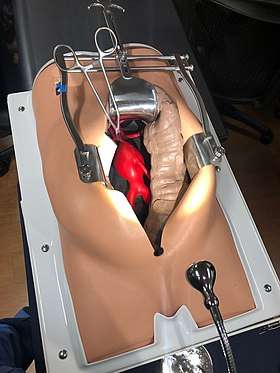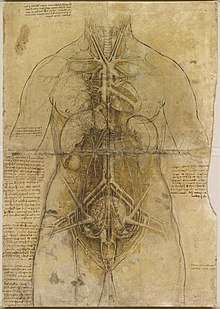Vascular surgery
Vascular surgery is a surgical subspecialty in which diseases of the vascular system, or arteries, veins and lymphatic circulation, are managed by medical therapy, minimally-invasive catheter procedures, and surgical reconstruction. The specialty evolved from general and cardiac surgery as well as minimally invasive techniques pioneered by interventional radiology. The vascular surgeon is trained in the diagnosis and management of diseases affecting all parts of the vascular system excluding the coronaries and intracranial vasculature.
 | |
| Occupation | |
|---|---|
| Names | Doctor, Medical Specialist |
Occupation type | Specialty |
Activity sectors | Medicine |
| Description | |
Education required | |
Fields of employment | Hospitals, Clinics |
History
Early leaders of the field included Russian surgeon Nikolai Korotkov, noted for developing early surgical techniques, American interventional radiologist Charles Theodore Dotter who is credited with inventing minimally invasive angioplasty, and Australian Robert Paton, who helped the field achieve recognition as a specialty. Edwin Wylie of San Francisco was one of the early American pioneers who developed and fostered advanced training in vascular surgery and pushed for its recognition as a specialty in the United States in the 1970s.
Evolution

The specialty continues to be based on operative arterial and venous surgery but since the early 1990s has evolved greatly. There is now considerable emphasis on minimally invasive alternatives to surgery. The field was originally pioneered by interventional radiologists, chiefly Dr. Charles Dotter, who invented angioplasty. Of note, Dr. Thomas Fogarty invented the balloon catheter which enabled angioplasty. Further development of the field has occurred via joint efforts between interventional radiology, vascular surgery, and interventional cardiology. This area of vascular surgery is called Endovascular Surgery or Interventional Vascular Radiology, a term that some in the specialty append to their primary qualification as Vascular Surgeon. Endovascular and endovenous procedures can now form the bulk of a vascular surgeon's practice.
The development of endovascular surgery has been accompanied by a gradual separation of vascular surgery from its origin in general surgery. Most vascular surgeons would now confine their practice to vascular surgery and similarly general surgeons would not be trained or practice the larger vascular surgery operations or most endovascular procedures. More recently, professional vascular surgery societies and their training program have formally separated "Vascular Surgery" into a separate specialty with its own training program, meetings, accreditation. Notable societies are Society of Vascular Surgery (SVS), USA; Australia and New Zealand Society of Vascular Surgeons (ANZ SVS). Local societies also exist e.g. New South Wales Vascular and Melbourne Society of Vascular Surgeons (MVSA). Larger societies of surgery actively separate and encourage specialty surgical societies under their umbrella e.g. Royal Australasian College of Surgeons (RACS).
SIR (Society of Interventional Radiology) remains intimately involved with the practice of endovascular therapy. Many of its members form part of a multi-disciplinary team treating vascular disorders alongside vascular surgeons. Although in many parts of the world vascular surgeons have evolved to now work alone.
Currently
Arterial and venous disease treatment by angiography, stenting, and non-operative varicose vein treatment sclerotherapy, endovenous laser treatment are rapidly replacing major surgery in many first world countries. These newer procedures provide reasonable outcomes that are comparable to surgery with the advantage of short hospital stay (day or overnight for most cases) with lower morbidity and mortality rates. Historically performed by interventional radiologists, vascular surgeons have become increasingly proficient with endovascular methods. The durability of endovascular arterial procedures is generally good especially when viewed in the context of their common clinical usage i.e. arterial disease occurring in elderly patients and usually associated with concurrent significant patient comorbidities especially ischemic heart disease. The cost savings from shorter hospital stays and less morbidity are considerable but are somewhat balanced by the high cost of imaging equipment, construction and staffing of dedicated procedural suites, and of the implant devices themselves. The benefits for younger patients and in venous disease are less persuasive but there are strong trends towards nonoperative treatment options driven by patient preference, health insurance company costs, trial demonstrating comparable efficacy at least in the medium term.
A recent trend in the United States is the stand-alone day angiography facility associated with a private vascular surgery clinic, thus allowing treatment of most arterial endovascular cases conveniently and possibly with lesser overall community cost. Similar non-hospital treatment facilities for non-operative vein treatment have existed for some years and are now widespread in many countries.
NHS England conducted a review of all 70 vascular surgery sites across England in 2018 as part of its Getting It Right First Time programme. The review specified that vascular hubs should perform at least 60 abdominal aortic aneurysm procedures and 40 carotid endarterectomies a year. 12 trusts missed both targets and many more missed one of them. A programme of concentrating vascular surgery in fewer centres is proceeding.[1]
Scope
| Vascular surgery | |
|---|---|
| ICD-9-CM | 38-39 |
| MeSH | D014656 |
| OPS-301 code | 5-38...5-39 |
Vascular surgery encompasses surgery of the aorta, carotid arteries, and lower extremities, including the iliac, femoral, and tibial arteries. Vascular surgery also involves surgery of veins, for conditions such as May–Thurner syndrome and for varicose veins. In some regions, vascular surgery also includes dialysis access surgery and transplant surgery.
The main disease categories and procedures associated with them are listed below.
Investigations
Major trials
- Netherland Vascular Study[2]
- MASS Trial – The Multicentre Aneurysm Screening Study (MASS) trial, which found reduced mortality after screening for abdominal aortic aneurysms in the UK.[3]
- UK Small Aneurysm Trial – 1090 patients; AAA 4-5.5 cm; Immediate surgery vs. ultrasound surveillance (and treatment for rapid expansion or AAA >5.5); 30-day mortality after elective AAA repair is 5.8%. No difference in survival.[4]
- ADAM VA Cooperative Group Trial – 73451 VA patients screened with no known hx of aneurysm; Age 50-79; AAA 4.0-5.4 cm; similar conclusion to Uk Small Aneurysm Trial.[5]
- Joint Vascular Research Group Trial – 284 patients; Study the relationship between intraoperative intravenous heparinization, blood loss during surgery and thrombotic complications. Conclusion: Intraoperative heparin, given before aortic cross clamping, is an important prophylactic against perioperative MI in aortic aneurysm surgery.[6]
Training
Previously considered a field within general surgery, it is now considered a specialty in its own right. As a result, there are two pathways for training in the United States. Traditionally, a five-year general surgery residency is followed by a 1-2 year (typically 2 years) vascular surgery fellowship. An alternative path is to perform a five or six year vascular surgery residency. In many countries, Vascular surgeons can opt into doing additional training in cardiac surgery as well post-residency.
Programs of training are slightly different depending on the region of the world one is in.
| Country | Standards body | Professional representation | Minimum Length of training (post intern) |
|---|---|---|---|
| Australia and New Zealand | Royal Australasian College of Surgeons | Australian & New Zealand Society of Vascular Surgery (ANZSVS) | 6 years |
| Canada | Royal College of Surgeons of Canada | Canadian Society for Vascular Surgery | 5 years |
| United Kingdom | Royal College of Surgeons of England, Royal College of Surgeons of Edinburgh | Vascular Society of Great Britain and Ireland http://www.vascularsociety.org.uk/ | 8 years |
| United States | American Board of Surgery, American Osteopathic Board of Surgery | Society for Vascular Surgery | 5 years ( 4 via 5-year integrated Vascular Surgery Residency)[7] |
| Italy | 5 years | ||
| Iran | Iran National Board of Vascular Surgery | Iranian College of Vascular Surgeons | 7 years ( 4 years of general surgery + 3 years of vascular surgery) |
See also
- Society for Vascular Surgery, the major American professional society
- Ischemia-repurfusion injuries of the appendicular musculoskeletal system
References
- "Trusts reveal plans to centralise services after GIRFT review". Health Service Journal. 19 March 2018. Retrieved 13 May 2018.
- Hooi JD; Kester AD; Stoffers HE; Overdijk MM; van Ree JW; Knottnerus JA (April 2001). "Incidence of and risk factors for asymptomatic peripheral arterial occlusive disease: a longitudinal study". Am J Epidemiol. 153 (7): 666–72. doi:10.1093/aje/153.7.666. PMID 11282794.
- Ashton HA; Buxton MJ; Day NE; et al. (November 2002). "The Multicentre Aneurysm Screening Study (MASS) into the effect of abdominal aortic aneurysm screening on mortality in men: a randomised controlled trial". Lancet. 360 (9345): 1531–9. doi:10.1016/S0140-6736(02)11522-4. PMID 12443589.
- "Mortality results for randomised controlled trial of early elective surgery or ultrasonographic surveillance for small abdominal aortic aneurysms. The UK Small Aneurysm Trial Participants". Lancet. 352 (9141): 1649–55. November 1998. doi:10.1016/S0140-6736(98)10137-X. PMID 9853436.
- Lederle FA; Wilson SE; Johnson GR; et al. (August 1994). "Design of the abdominal aortic Aneurysm Detection and Management Study. ADAM VA Cooperative Study Group". J Vasc Surg. 20 (2): 296–303. doi:10.1016/0741-5214(94)90019-1. PMID 8040955.
- Thompson JF; Mullee MA; Bell PR; et al. (July 1996). "Intraoperative heparinisation, blood loss and myocardial infarction during aortic aneurysm surgery: a Joint Vascular Research Group study". Eur J Vasc Endovasc Surg. 12 (1): 86–90. doi:10.1016/S1078-5884(96)80281-4. PMID 8696904.
- VascularWeb: New Vascular Surgery Training Paradigms